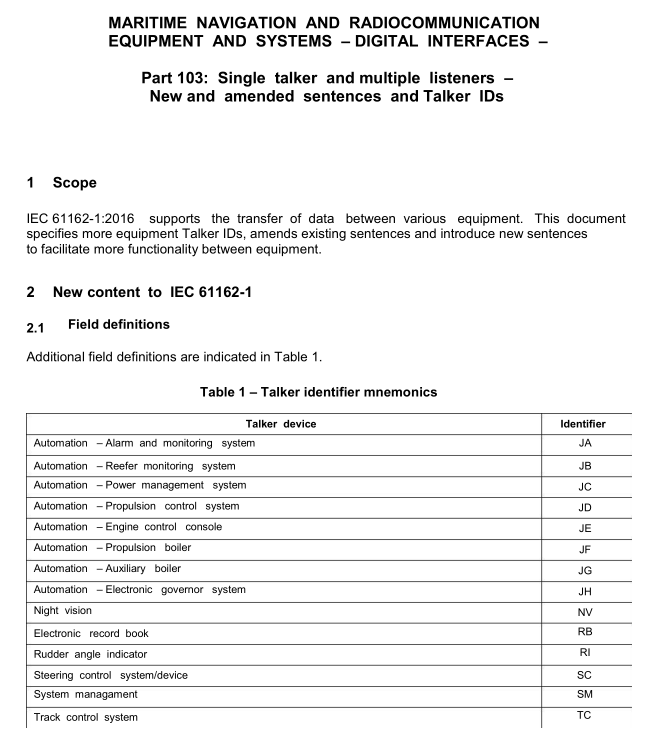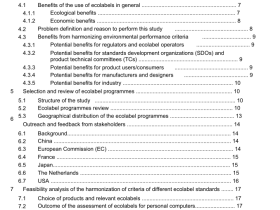IEC PAS 61162-103 pdf – Maritime navigation and radiocommunication equipment and systems – Digital interfaces – Part 103: Single talker and multiple listeners – New and amended sentences and Talker IDs

IEC PAS 61162-103 pdf – Maritime navigation and radiocommunication equipment and systems – Digital interfaces – Part 103: Single talker and multiple listeners – New and amended sentences and Talker IDs
Comments:
1)The first field specifies the total number of sentences used for a message,minimum value 1. The second fieldidentifies the order of this sentence in the message,minimum value 1. These fields are integer flelds with nodecimal point or decimal digits. These cannot be null fields.
2) The sequential message identifier relates all sentences that belong to a group of multiple sentences (i.e.
message).Multiple sentences (see Comment 1) with the same sequential message identifier,make up onemessage. This field is an integer field with no decimal point or decimal digits.
3)This field is used to indicate a sentence that is a status report of current settings or a confguration command
changing settings. This field shall not be null.
R = Sentence is a status report of current settings (use for a reply to a query).
c= Sentence is a configuration command to change settings. A sentence without “C” is not a command.
4) The equipment field contains the two character talker ID of the destination equipment when this sentence is sent
as a command as designated by the “Sentence status flag”field,and identifies the device type for which thesentence is targeted.When this sentence is a report(e.g. in response to a query) as designated by the “Sentencestatus flag” field,the equipment type field contains the talker lD of the equipment generating the sentence.
5) o ..nin
The unique identifier identifies the same equipment .irrespective of command versus response: For commands itidentifies the equipment intended to receive the command. For responses it identifies the equipment that actuallyreceived the command. Under normal conditions the response will be received from the equipment for which thecommand was intended. Equipment should only send one or more response sentences in response to commandsentences received and should not use response sentences for general reporting.The unique identfier may benull.
6)The property identifier is a variable length integer field that identifies a parameter that can be set as defined in
an applicable equipment standard and is intended for commissioning settings.
7) The “Value of property to be set” is a variable length character string representing the intended configuration
parameter value when the sentence is a command and the current value when the sentence is a report. Characterstrings are concatenated to form a single long character string as the Value of the property to be set. Thecharacter string may contain both valid characters,see Table 2 of lEC 61162-1:2016, and reserved characters,see Table 1 of IEC 61162-1:2016.Reserved characters shall be represented using the “nmethod (see 7.1.4 ofIEC 61162-1:2016).
Examples of EPM sentence command and response:
The example shows an ECDIS (with a Talker ID of “”) setting a configuation paprameter 1234 of an AlIStransponder (with a Talker ID of “A””) for a long parameter value of “This-is-an-example-of-a-long-parameterwhich-continues-over-multiple-messages”. In this example,the unique identifier is the ‘value of the MMSl of theAlS “503123450” and the Sequentalmessage identifier is 98. The ECDIS would send the following command:$EIEPM,02,01,98,C,Al,503123450,1234,This-is-an-example-of-a-long-parameter*53
$EIEPM,02,02,98,C,Al,503123450,1234,-which-continues-over-multiple-messages*09
SEIAIQ,EPV*hh
The AIS would send the following response (in this example the Sequental message identifier is 25):SEIEPM,02,01,25,R,Al,503123450,1234,This-is-an-example-of-a-long-parameter-wh*76
SEIEPM,02,02,25,R,Al.,503123450,1234,ich-continues-over-multiple-messages*2C
2.2.3 NLS- Navigation light status
This sentence provides the status of the navigation lights as reported by a navigation lightscontroller.An example use case is for reporting the status of required navigation lights from the
navigation lights controller to the voyage data recorder and other shipboard equipment ordisplays.The NLS sentence can support approximately 800 unique lights. As an example, the
IMo soLAs required number of navigation lights is typically between 32 and 64.Theassignment and configuration of the light numeric identifiers are typically defined or configured
within the navigation lights controller.
This sentence cannot be used to command or change the status of any navigation light. Thissentence may be queried, and a response may consist of multiple NLS sentences.
$–NLS,xx,xx,XX,X,x.x,h,x.x….,x.x,h,x.x*hh
Light/Status pair n 7)
Variable number of Light/Status pairs 6)Remaining working hours 6)
Status of light 5)
L Light numeric identifier 4)
LNumber of lights in this sentence, 1 to 8 3)Sequential message identifier 2)
– Sentence number 1)
Total number of sentences for this message 1)
Comments:
1)The number of Navigation LightStatus pairs reported may require multiple sentences. The “Total number of
sentences for this message”field specifies the total number of sentences used for a message,range 01 – 99.This field shall not be a null field. The “Sentence number”field identifies the order of this sentence within a multi-sentence message; range 01- 99. This field may be a null field when there is only one sentence per message,as when the “Total number of sentences for this message”field is set to a value of 01.
2)The “sequential message identifier”field is a number 00 to 99,used to identify different messages. This field
identifies all sentences that belong to a group of multiple sentences (i.e. message).Multiple sentences (seecomment 1) with the same sequential message identifier value make up one message. The sequential messageidentfier is a number, 00 to 99,used to identify different multi-sentence messages. This field may be a null fieldwhen there is only one sentence per message,as when the “Total number of sentences for this message” is setto a value of 01.
3) Number of LightStatus pairs in this sentence: indicates how many lights and their status values are provided
after this parameter,within this sentence,and the light numernic identifiers ranging from 1 to 8. A dfferent mix ofsingle,two,or even three digit light numeric identfiers and the use of multiple sentences to make up a messagewll reduce the number of allowed LightStatus pairs in accordance with sentence length requirements. The actualnumber of Light/Status pairs must be such that the total number of characters in the sentence does not exceedthe “82-character” limit.”See examples below.









